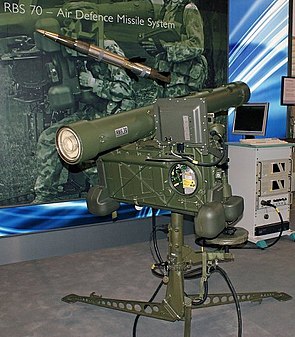Robotic system 70
| Robotic system 70 | |
|---|---|
| General Information | |
| Type | Anti-aircraft missile |
| Manufacturer | Saab Bofors Dynamics (SBD) |
| development | 1969 |
| Commissioning | 1977 |
| Technical specifications | |
| length | 1.32 m |
| diameter | 106 mm |
| Combat weight | 8.2 kg |
| span | 320 mm |
| drive | Solid - rocket engine |
| speed | 535 m / s (Mk.0), 670 m / s (Mk.2) |
| Range | 0.25-7 km |
| Furnishing | |
| Target location | Passive, laser targeting |
| Warhead | 1.1 kg splitter / shaped charge |
| Detonator | Impact and proximity fuses |
| Weapon platforms |
MANPADS Wiesel 2 Ocelot (LeFlaSys) |
| Lists on the subject | |
The robot system 70 ( RBS 70 for short ) is a Swedish , shoulder-supported short - range surface-to-air guided missile system (MANPADS) for combating helicopters and fighter planes at low altitudes.
development
The robot system 70 was designed to complement the existing Swedish air defense systems. It should be cheap to buy, easy to use and effective for short trips. Before the RBS-70 system, the Swedish Armed Forces used US anti-aircraft missile systems such as the HAWK FlaRak system and the outdated Redeye MANPAD . The system was developed and manufactured by the Swedish company Saab Bofors Dynamics (SBD) . The system was introduced into the army in 1977. The RB-70 guided weapons are used. By the end of 2018, 1,600 launchers and 18,000 guided missiles had been produced and exported worldwide.
technology
The guided weapon is housed in a GRP transport and launch tube and is started directly from this. The system is usually carried by two men. One carries the launching device with steering device and frame, the other carries two missile containers. It takes around 30 seconds to prepare for fire readiness. External radar systems can assign targets to the RBS 70 system. Sweden uses the PS-70 Giraffe radar system . Radar devices of the type HARD or PSTAR can also be used. The radar data are shown on the display of the position display device on the starter unit.
RBS 70 works according to the SACLOS steering system (semi-automatic command steering). The guided weapon is brought to the target by means of a laser beam . The shooter only needs to follow the target in the crosshairs . If the target comes within the proximity fuse's response radius, the fragmentation warhead is detonated. In the event of a direct hit, the warhead is detonated by the impact fuse. RBS-70 can also be used against ground targets.
The first version (Mk. 0) of the RBS 70 dates from the 1970s and, compared to other shoulder-based air defense systems, had a lower percentage hit probability and a shorter range. These deficiencies have been corrected in the much more modern versions Mk. 1 and Mk. 2. According to the manufacturer, these models achieve a hit expectation of 90 to 95%.
variants
- RBS 70 (Mk.0): First serial version introduced in 1977. Combat range 5000 m, operating altitude 3000 m, flight speed Mach 1.5.
- RBS 70 (Mk.1): Second production version introduced in 1990. Combat range 6000 m, airspeed Mach 1.6.
- RBS 70 (Mk.2): Third production version introduced in 1993. With improved electronics and a larger warhead with proximity fuse. Combat range 7000 m, operating altitude 4000 m, airspeed Mach 1.8.
- RBS 70 (BOLIDE): Version introduced in 2001. With improved electronics and a new BOLIDE guided missile. Combat range over 9000 m, operational altitude up to 5000 m, flight speed over Mach 2.0. For fighting cruise missiles and drones
- RBS 70NG: Version presented in 2011. Completely suitable for night combat thanks to new target optics, new thermal imaging device and improved electronics. Uses the BOLIDE guided missiles.
- RBS 90: Version introduced in 1991. With remote-controlled double or triple turret. Thanks to the thermal imaging device and PS-91 HARD 3D search radar, this version is suitable for night combat. The Mk. 1 and Mk. 2 guided missiles are used.
User states
-
 Argentina
Argentina
-
 Australia
Australia
-
 Bahrain
Bahrain
-
 Bangladesh
Bangladesh
-
 Brazil
Brazil
-
 Finland
Finland
-
 Indonesia
Indonesia
-
 Iran
Iran
-
 Ireland
Ireland
-
 Latvia
Latvia
-
 Lithuania
Lithuania
-
 Mexico
Mexico
-
 Norway ( Norwegian Army )
Norway ( Norwegian Army ) -
 Pakistan
Pakistan
-
 Singapore
Singapore
-
 Sweden
Sweden
-
 Czech Republic
Czech Republic
-
 Thailand
Thailand
-
 Tunisia
Tunisia
-
 United Arab Emirates
United Arab Emirates
-
 Venezuela
Venezuela
Web links
- RBS 70 on http://www.saabgroup.com (English)
- RBS 70 on www.army-technology.com (English)
Individual evidence
- ↑ a b Saab to Deliver RBS 70 Mk II Missiles to the Czech Army. In: defencetalk.com. Defense Talk, March 18, 2019, accessed on May 14, 2019 .
